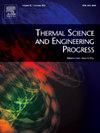用于工业过程加热脱碳的吸收式热泵:性能、现状和新发展
IF 5.1
3区 工程技术
Q2 ENERGY & FUELS
引用次数: 0
摘要
在工业中,对生产、加工或成品的过程热有巨大的需求。工业过程的热量主要来自化石燃料的燃烧,因此,如果工业要减少碳足迹,就需要使用可持续的热源。在这种情况下,吸收式热泵可以提供一个可行的解决方案,以减轻工业热消耗对环境的影响。本文回顾和讨论了工业加热应用(≥80°C)的三种吸收式热泵的最新进展:吸收式压缩热泵,吸收式热泵(I型热泵)和吸收式热变压器(II型热泵)。目前可用的水/锂I型热泵技术的最大供热温度限制为100°C,温度提升可达50°C,热cop为1.65-1.80。水/LiBr II型热泵的最大供热温度为185°C,温度升程高达50°C,热cop为0.33-0.48。氨/水吸收-压缩热泵的最大供热温度为160°C,温度升程高达110°C,电气cop为2.7-7.3。然而,为了充分挖掘这些热泵在过程工业中的潜力,研究和开发应侧重于提高供热温度和温度升程,以超越目前的极限。使用这些热泵来回收工业废热将对过程工业的脱碳做出相当大的贡献。本文章由计算机程序翻译,如有差异,请以英文原文为准。
Absorption-based heat pumps for decarbonization of industrial process heating: performance, current status, and new developments
In industry, there is a huge demand for process heat to produce, process, or finish products. Industrial process heat originates mainly from the combustion of fossil fuels, so industries need to use sustainable heat supplies if they are to reduce their carbon footprints. In this context, absorption-based heat pumps can offer a viable solution to mitigating the environmental impact of industrial heat consumption. This article reviews and discusses the state of the art of three types of absorption-based heat pumps for industrial heating applications (≥80 °C): absorption-compression heat pumps, absorption heat pumps (Type I heat pumps), and absorption heat transformers (Type II heat pumps). The water/LiBr Type I heat pump technologies currently available are restricted to a maximum heat supply temperature of 100 °C and a temperature lift up to 50 °C with thermal COPs of 1.65–1.80. The water/LiBr Type II heat pumps have a maximum heat supply temperature of 185 °C and a temperature lift of up to 50 °C with thermal COPs of 0.33–0.48. The ammonia/water absorption-compression heat pumps have a maximum heat supply temperature of 160 °C and a temperature lift of up to 110 °C with electrical COPs of 2.7–7.3. However, to fully exploit the potential of these heat pumps in process industries, research and development should focus on increasing heat supply temperature and temperature lift beyond the current limits. The use of these heat pumps to recover industrial waste heat will make a considerable contribution to the decarbonisation of the process industries.
求助全文
通过发布文献求助,成功后即可免费获取论文全文。
去求助
来源期刊

Thermal Science and Engineering Progress
Chemical Engineering-Fluid Flow and Transfer Processes
CiteScore
7.20
自引率
10.40%
发文量
327
审稿时长
41 days
期刊介绍:
Thermal Science and Engineering Progress (TSEP) publishes original, high-quality research articles that span activities ranging from fundamental scientific research and discussion of the more controversial thermodynamic theories, to developments in thermal engineering that are in many instances examples of the way scientists and engineers are addressing the challenges facing a growing population – smart cities and global warming – maximising thermodynamic efficiencies and minimising all heat losses. It is intended that these will be of current relevance and interest to industry, academia and other practitioners. It is evident that many specialised journals in thermal and, to some extent, in fluid disciplines tend to focus on topics that can be classified as fundamental in nature, or are ‘applied’ and near-market. Thermal Science and Engineering Progress will bridge the gap between these two areas, allowing authors to make an easy choice, should they or a journal editor feel that their papers are ‘out of scope’ when considering other journals. The range of topics covered by Thermal Science and Engineering Progress addresses the rapid rate of development being made in thermal transfer processes as they affect traditional fields, and important growth in the topical research areas of aerospace, thermal biological and medical systems, electronics and nano-technologies, renewable energy systems, food production (including agriculture), and the need to minimise man-made thermal impacts on climate change. Review articles on appropriate topics for TSEP are encouraged, although until TSEP is fully established, these will be limited in number. Before submitting such articles, please contact one of the Editors, or a member of the Editorial Advisory Board with an outline of your proposal and your expertise in the area of your review.
 求助内容:
求助内容: 应助结果提醒方式:
应助结果提醒方式:


